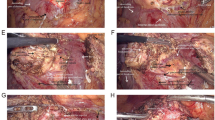Abstract
Background
In radical operations for gastric cancer, a balance between the quality of lymph node dissection and safety of surgery must be ensured. During suprapancreatic lymphadenectomy in laparoscopic gastrectomy (LG), an adequate operative field should be safely and effectively established to reduce pancreas-related complications. We present a novel approach that avoids direct compression of the pancreas in LG and describe the surgical outcomes of this method.
Methods
We historically compressed the pancreas during suprapancreatic lymph node dissection in LG to obtain an adequate operative field but have since modified our operative technique. In our new method introduced in March 2016, the operative field is established by pulling and controlling the connective tissues along the inferior border of the pancreas and the nerves along the common hepatic and splenic arteries, instead of directly compressing the pancreas itself. We compared 51 patients in the compression group (January 2015–February 2016) and 45 patients in the compressionless group (March 2016–January 2017) in terms of surgical outcomes, including the amylase concentration in the drainage fluid and postoperative complications.
Results
The amylase concentrations in the compressionless group were significantly lower on postoperative days 1 and 3 (p < 0.001 and p = 0.013, respectively) compared with the compression group. The rates of severe postoperative pancreatic fistula and intra-abdominal infectious complications decreased from 11.8 to 2.2% (p = 0.116) and from 17.6 and 2.2% (p = 0.018), respectively.
Conclusions
Our approach, termed “pancreas-compressionless gastrectomy,” can be considered a safe and useful method to prevent postoperative infectious complications in LG.


Similar content being viewed by others
References
Kitano S, Iso Y, Moriyama M, Sugimachi K. Laparoscopy-assisted Billroth I gastrectomy. Surg Laparosc Endosc. 1994;4(2):146–8.
Vinuela EF, Gonen M, Brennan MF, Coit DG, Strong VE. Laparoscopic versus open distal gastrectomy for gastric cancer: a meta-analysis of randomized controlled trials and high-quality nonrandomized studies. Ann Surg. 2012;255(3):446–56.
Hosono S, Arimoto Y, Ohtani H, Kanamiya Y. Meta-analysis of short-term outcomes after laparoscopy-assisted distal gastrectomy. World J Gastroenterol. 2006;12(47):7676–83.
Yakoub D, Athanasiou T, Tekkis P, Hanna GB. Laparoscopic assisted distal gastrectomy for early gastric cancer: is it an alternative to the open approach? Surg Oncol. 2009;18(4):322–33.
Zeng YK, Yang ZL, Peng JS, Lin HS, Cai L. Laparoscopy-assisted versus open distal gastrectomy for early gastric cancer: evidence from randomized and nonrandomized clinical trials. Ann Surg. 2012;256(1):39–52.
Katai H, Sasako M, Fukuda H, et al. Safety and feasibility of laparoscopy-assisted distal gastrectomy with suprapancreatic nodal dissection for clinical stage I gastric cancer: a multicenter phase II trial (JCOG 0703). Gastric Cancer. 2010;13(4):238–44.
Obama K, Okabe H, Hosogi H, Tanaka E, Itami A, Sakai Y. Feasibility of laparoscopic gastrectomy with radical lymph node dissection for gastric cancer: from a viewpoint of pancreas-related complications. Surgery. 2011;149(1):15–21.
Fujita T, Ohta M, Ozaki Y, et al. Collateral thermal damage to the pancreas by ultrasonic instruments during lymph node dissection in laparoscopic gastrectomy. Asian J Endosc Surg. 2015;8(3):281–8.
Jeong O, Ryu SY, Zhao XF, Jung MR, Kim KY, Park YK. Short-term surgical outcomes and operative risks of laparoscopic total gastrectomy (LTG) for gastric carcinoma: experience at a large-volume center. Surg Endosc. 2012;26(12):3418–25.
Haverkamp L, Weijs TJ, van der Sluis PC, van der Tweel I, Ruurda JP, van Hillegersberg R. Laparoscopic total gastrectomy versus open total gastrectomy for cancer: a systematic review and meta-analysis. Surg Endosc. 2013;27(5):1509–20.
Dindo D, Demartines N, Clavien PA. Classification of surgical complications: a new proposal with evaluation in a cohort of 6336 patients and results of a survey. Ann Surg. 2004;240(2):205–13.
Tsujiura M, Hiki N, Ohashi M, et al. Excellent long-term prognosis and favorable postoperative nutritional status after laparoscopic pylorus-preserving gastrectomy. Ann Surg Oncol. 2017. doi:10.1245/s10434-017-5828-0
Fukunaga T, Hiki N, Tokunaga M, et al. Left-sided approach for suprapancreatic lymph node dissection in laparoscopy-assisted distal gastrectomy without duodenal transection. Gastric Cancer. 2009;12(2):106–12.
Fukunaga T, Hiki N, Kubota T, et al. Oncologic outcomes of laparoscopy-assisted distal gastrectomy for gastric cancer. Ann Surg Oncol. 2013;20(8):2676–82.
Irino T, Hiki N, Ohashi M, Nunobe S, Sano T, Yamaguchi T. The Hit and Away technique: optimal usage of the ultrasonic scalpel in laparoscopic gastrectomy. Surg Endosc. 2016;30(1):245–50.
Moore EE, Cogbill TH, Malangoni MA, et al. Organ injury scaling, II: Pancreas, duodenum, small bowel, colon, and rectum. J Trauma. 1990;30(11):1427–29.
Gao T, Lau BE, Yamaguchi T, et al. Experimental analyses of the cavitation generated by ultrasonically activated surgical devices. Surg Today. 2016;47(1), 122–129
Migita K, Matsumoto S, Wakatsuki K, et al. The anatomical location of the pancreas is associated with the incidence of pancreatic fistula after laparoscopic gastrectomy. Surg Endosc. 2016;30(12): 5481–5489
Kobayashi N, Shinohara H, Haruta S, et al. Process of pancreas head as a risk factor for postoperative pancreatic fistula in laparoscopic gastric cancer surgery. World J Surg. 2016;40(9):2194–201.
Acknowledgement
No grant support or institutional/corporate affiliations are associated with this study.
Disclosure
The authors have no conflicts of interest to declare.
Author information
Authors and Affiliations
Corresponding author
Rights and permissions
About this article
Cite this article
Tsujiura, M., Hiki, N., Ohashi, M. et al. “Pancreas-Compressionless Gastrectomy”: A Novel Laparoscopic Approach for Suprapancreatic Lymph Node Dissection. Ann Surg Oncol 24, 3331–3337 (2017). https://doi.org/10.1245/s10434-017-5974-4
Received:
Published:
Issue Date:
DOI: https://doi.org/10.1245/s10434-017-5974-4




